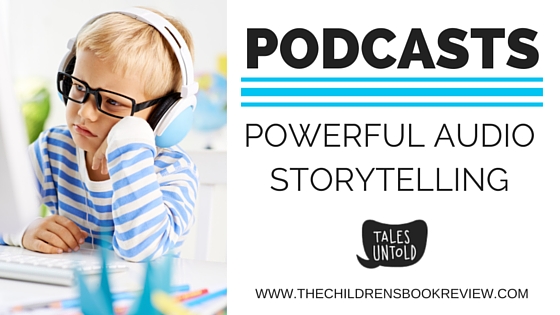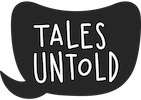Written by Nick Vidinsky, founder of Tales Untold Media
The Children’s Book Review | August 27, 2015

For the record, I’m neither a curmudgeon nor a technophobe. I don’t think we should all kill our TVs, melt down our iPhones and go back to simpler times when only the world’s elite had access to information. But when a tool is leaned on too much, it becomes a crutch.
Quickly, some facts: I’m probably not the first to tell you that screen time among young children in our society is increasing to alarming levels. According to a 2013 study from Common Sense Media, 38% of American children under 2 years old have used mobile devices. (That number balloons to 78% when you include children up to 8 years old.) The average time children spend on these mobile devices tripled over a 2 year period.[1]
And let’s not lay all the screen time blame at the feet of our trusted phones. On average, children under 2 spend nearly triple the amount of time watching television every day (55 minutes) than they do reading or being read to (19 minutes).[2] Take a second to let that sink in.
While I’m busy playing Debbie Downer, let me drop one more on you: another recent study shows that children ages 3 to 5 whose parents read to them on digital devices have lower reading comprehension than those whose parents use regular old books. Why? Because more time is spent focusing on using the device itself, rather than that pesky reading part.[3]
So what does all this tell us? Our kids need to spend less time staring at screens. And it’s our role as parents to make that happen.
Now, if you’re fresh out of ideas, there are tons of great resources for fun activities you can do with your kids. But let’s face it. You’re busy; you’re tired. It’s not always feasible to whip out 12 pipe cleaners, an old shoe horn, 3 sticks of gum and a tube of glitter. And as much as you read to your child, you can’t always do so at the drop of a hat. TVs and mobile devices make great babysitters precisely because there are (frequent) times when you need a few minutes to get something done and, frankly, for the kids to just mellow out.
This is precisely why I started producing podcasts for kids.
If you’re not familiar with podcasts yet, you will be very soon. 17% of adults in the U.S. have listened to a podcast in the last month.[4] And that number will continue to rise, especially as new cars become Internet-enabled and you’ll be able to dial up any show you want, any time.
Why are podcasts so popular? Well, just like in the days when families would gather around the radio for an episode of The Adventures of Philip Marlowe, there’s a certain power that audio storytelling has over us. It’s an intimate, personal experience that engages your imagination and feeds your brain. You may not realize it, but processing audio and creating your own visuals in your mind requires active participation on your part. You’re not just vegging out.
In fact, a recent study published in the journal Pediatrics found that when young children listen to stories, there is increased activity in the part of the brain that integrates sound and visuals. In other words, their little brains are busy visualizing what they’re hearing. What’s more, the researchers saw higher brain activity among those kids who listen to stories more often. It’s like they’re in better imaginative shape. When interviewed by The New York Times in an article about the study, lead author Dr. John S. Hutton suggested this could have larger implications with respect to videos and picture books:
“When we show them a video of a story, do we short circuit that process a little? Are we taking that job away from them? They’re not having to imagine the story; it’s just being fed to them.”
To be clear, podcasts are different than listening to audiobooks or a caregiver reading aloud. Aside from the episodic nature of podcasting, the medium itself is completely unique. Writing (or depending on the podcast, simply conversing) for the ears is very different than writing for the eyes, in the same way that books and screenplays are different beasts.
What’s more, podcasts–complete with music, sound effects and professional narration–can develop characters and storylines over time, and challenge listeners with increasing complexity of language. Nothing aids language development for kids better than listening. In fact, students can listen to information that’s two or three grade levels above their reading level.[5] It’s no wonder, then, that teachers are bringing podcasts into the classroom.
If you haven’t discovered podcasts yet–for you or your kids–I urge you to check it out. Whether you’re looking for fiction, non-fiction, comedy, drama, well-crafted prose or just a good conversation, it’s all out there for you to experience and learn.
Without staring at a screen.
—
 Nick Vidinsky is founder of Tales Untold Media: producers of original audio podcasts for young kids, available in the Tales Untold app. When he and his wife Kate aren’t chasing their two young children around the San Francisco Bay Area, Nick likes to listen to comedy podcasts while brewing beer in the garage.
Nick Vidinsky is founder of Tales Untold Media: producers of original audio podcasts for young kids, available in the Tales Untold app. When he and his wife Kate aren’t chasing their two young children around the San Francisco Bay Area, Nick likes to listen to comedy podcasts while brewing beer in the garage.
[1] https://www.commonsensemedia.org/about-us/news/press-releases/new-research-from-common-sense-media-reveals-mobile-media-use-among
[2] https://www.commonsensemedia.org/about-us/news/press-releases/new-research-from-common-sense-media-reveals-mobile-media-use-among
[3] https://www.nytimes.com/2014/10/12/us/is-e-reading-to-your-toddler-story-time-or-simply-screen-time.html
[4] http://www.statista.com/statistics/270365/audio-podcast-consumption-in-the-us/
[5] http://ww2.kqed.org/mindshift/2015/03/11/what-teens-are-learning-from-serial-and-other-podcasts/

2 Comments
Pingback: FMP – Proposal | bakabarrett
Hurrah! I agree that listening is a great literacy tool for kids. I’d love for more of my books to be recorded.